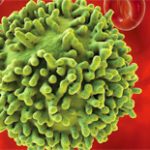The CD44 receptor is highly expressed on macrophages and other cells of the immune system. It is a phagocytic receptor that can also extracellularly interact with ligands, such as lubricin, and interact intracellularly to activate signaling pathways. PP2A is a highly conserved member of a family of enzymes that regulate signal transduction of many cellular processes.
When lubricin binds CD44 receptors on synovial macrophages, this activates recruitment and binding of PP2A enzymes to intracellular CD44 glycoproteins. Ultimately, this leads to inhibition of the NFκB inflammatory pathway. At homeostasis, CD44 receptors are covered by lubricin, acting as a sort of shield to prevent macrophage activation, Dr. Elsaid explained.
However, an inflammatory environment can decrease lubricin: Stimulation with IL‐1β downregulates lubricin, and such enzymes as neutrophil elastases may degrade it. This loss of lubricin upregulates the density of CD44 on macrophages. This results in increased NFκB inflammatory pathway signaling and inflammasome activation, ultimately leading to higher levels of activated IL‐1β and other inflammatory signals.
Using mouse and human tissue models, Dr. Elsaid and colleagues have explored whether these components—CD44, lubricin and PP2A—contribute to the pathogenesis of gout.
CD44 in Gout Pathophysiology
“We wanted to ask whether CD44 can mediate urate crystal phagocytosis and whether that is a new mechanism of urate crystal uptake,” said Dr. Elsaid.
Dr. Elsaid shared data from bone-derived macrophages from CD44 knockout mice (mice not expressing the CD44 receptor) and wild type mice (expressing the CD44 receptor). The wild-type mice showed a higher extent of uric crystal phagocytosis, suggesting that CD44 may be involved in the uptake process.4
“We also wanted to think pharmacologically about whether targeting this receptor is going to give us a new mechanism in terms of addressing apical events in terms of urate crystal uptake,” said Dr. Elsaid.
Thus, the researchers used a monoclonal CD44 antibody, which induces the shedding of the CD44 extracellular region, preventing MSU crystal phagocytosis. The CD44 antibody reduced neutrophil and monocyte infiltration, as well as local IL‐1β release in vivo, illustrating its potential as a therapeutic target.4
PP2A in Gout Pathophysiology
Dr. Elsaid also shared findings about human monocyte experiments in which PP2A expression was knocked down via siRNA. He and his team found that when exposed to MSU crystals, monocytes with lower expression of PP2A showed increased IL‐1β gene expression and IL‐1β release compared with controls.5
They also used a drug known to increase PP2A activity, fingolimod, in the same model of human monocyte exposure to MSU crystals. Fingolimod, a sphingosine-1-phosphate receptor modulator with immunoregulatory properties, is already approved by the U.S. Food & Drug Administration for multiple sclerosis. The PP2A activator decreased IL‐1β release.5
